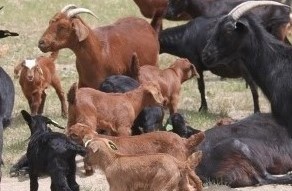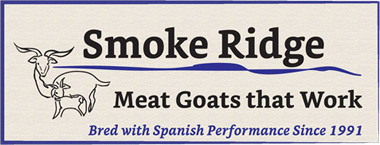
Income! Even though goats are more fun to raise than most other species of animal (yes, I am very positively biased), few of us can raise meat goats without earning money from our animal enterprise. Just above is the “picture” of what prices for market (slaughter) stock meat goats have been for the past many years… I update it each week, as a graph (picture) can and does show me the trends. We continue to see new all-time highs in market price per pound received, which bodes very well for meat goat producers. Do you have questions about how to get into the industry and participate in it successfully? Review the website above and following this page, order The Meat Goat Handbook if you like to read and look at almost 300 photos, and/or call Yvonne at 406-403-4070, or Craig at 406-470-2971. Smoke Ridge has been in business since 1991, and profitable since 1994, and Yvonne is (well) known for being of assistance to folks who are curious about “meat goating!”
The graph shows how the inescapable forces of supply and demand effect the value of our meat goats when offered in the market – low in the summer, when there are plenty of goats for customers’ dinners, and higher in the fall and winter as supplies are scarcer, and yet consumers still want to eat chevon for meals.
How will our goats pay for themselves and earn you money?
- Because we have about 6 months of winter, our does produce kids once per year in the Spring – as deer and elk do naturally.
- By being cautious and spending money only when necessary for the well-being of the goats and thus the business, we stay “in the black” and have some money left after the bills are paid.
- We sell neutered male kids and any physically-flawed female kids as market kids (for slaughter). Those kids should grow on pasture – without expensive purchased concentrates or grain – to reach the highly-desired 60 pound liveweight by late Fall/early Winter when prices paid for such kids rise to annual highs. The long-seen “low in the summer, high in the winter” sale price for meat goats is shown in the graph above.
- Orders are already being placed for current-year kids. They will be ready to leave their dams and start working for your meat goat enterprise (we deliver nationwide)… call Yvonne or Craig or email smokeridge@3rivers.net and get your reservations in soon!
The double-decked trailer on the way to deliver breeding goats to new and expanding producers

How can you get great meat goats from Smoke Ridge? Easily!
- Talk to Yvonne or Craig about which of our for sale goats would serve you best and reserve those goats. Typically, we sell current-year doe kids, as they adapt to new places more easily than mature does do. Yvonne is more than happy to assist you with preparing for the goats’ arrival and to answer any questions that you have about the how-when-where of “meat goating.”
- Send a 15% deposit (via personal check or money order) to confirm your reservation so that nobody else can buy those specific animals.
- When the goats are delivered (at the best time for both you and us) just hand Craig a cashier’s check for the 85% balance due.
- You will then receive a bill of sale, the interstate health certificate, and information about your new goats, who will happily unload from the trailer to start working for you!
How do we select which goats you will receive?
 We only sell goats to other producers that we would keep if we could double our pasture-size every year. Since our does (2 years old and older) raise 1.95 kids per year, our herd would be growing beyond our land’s carrying capacity if we didn’t sell the goats’ offspring! Since we find that we need just one buck per 75 (or more) does to successfully “settle” all of the does in one 21-28 day heat cycle, we can be very selective about which male kids to grow out as potential breeding bucks. The rest leave as neutered “market” kids. All female descendants of a goat that was named Floozy are going to stay right here. The few mother-goats that don’t do a terrific job at kidding time will stay here until they have proven themselves or will go into our freezer.
We only sell goats to other producers that we would keep if we could double our pasture-size every year. Since our does (2 years old and older) raise 1.95 kids per year, our herd would be growing beyond our land’s carrying capacity if we didn’t sell the goats’ offspring! Since we find that we need just one buck per 75 (or more) does to successfully “settle” all of the does in one 21-28 day heat cycle, we can be very selective about which male kids to grow out as potential breeding bucks. The rest leave as neutered “market” kids. All female descendants of a goat that was named Floozy are going to stay right here. The few mother-goats that don’t do a terrific job at kidding time will stay here until they have proven themselves or will go into our freezer.
Smoke Ridge meat goats
We call our Spanish-Boer composite meat goats Smoke Ridge. That’s not and will not become a breed, it just describes a goat that works for us here in Montana. We may have some pure Spanish goats available (at the same price as composite-breed goats of the same age and sex) but far fewer, so let us know if you’re thinking along those lines! As of January of 2022, the waiting list for Smoke Ridge goats is already getting filled up. Since we hate leaving people unhappy, if we don’t have enough goats available, we’ll do our best to put you in contact with someone who does.
How we raise our meat goats:
- Breed in late December (to have the kids born in late May) one buck to 75 females. All 7-month old doe kids in a separate breeding group, both Spanish-Boer composites as well as pure Spanish, with one pure Spanish buck. That way all of the pure Spanish doe kids are bred to a pure Spanish buck and the composite doe kids will have easy-birthing, very feisty kids.
- When winter snows cover all available forage, we feed grass-alfalfa mix hay (target protein 13.5%) at 3.5% of mature goats’ and 4% of kids’ bodyweight per day. We spread “flakes” of hay out on the pasture on clean snow, with at least 4′ between flakes so that no goat’s bottom is positioned above another goat’s meal.
- In late May/June, let the does kid out on pasture. Since there are no bushes or trees growing on our “high prairie” hillside, we have shelters that the goats can use if they need to get out of the wind or rain (or sleet or snow). Trust us, the goats know more than we humans do and will find shelter when they need some!
- Ear-tag all kids at birth, female kids in their right ear, male kids in their left ear. That way sorting through an alley by sex is very easy! We change colors of eartag each year on a 10-year rotation and also have the year of birth at the beginning of the number – for example, 16001 will be the tag number of the first kid born in 2016, 16002 the second. Sire and dam and all other information about that goat can be found in the computer by looking up its eartag number!
- In decent physical condition – neither under heavy parasite load or beyond their productive life expectancy – which we find to be 8-9 years for mostly Spanish/some Boer and 11-12 for pure Spanish, does should be well able to raise triplet kids (and even the very occasional – for us – quads) on pasture without assistance.
- Neuter or remove buck kids from the doeherd BY 90 days of age. We band when ear-tagging on the first day of the kids’ life should males have more than one teat on either side of the scrotum, a “bad bite,” or poor conformation, and to turn bucklings into “market” wethers.
- Leave doekids and wethers (neutered males) with the doeherd. Does will “dry up” naturally by approximately three months following kidding. The kids live with and learn how to be a goat in the herd from their mothers, aunts and cousins.
- Doelings (current year doe kids) that are leaving to go to new owners depart, together with other buddies, after they are three months old and it’s convenient for the buyers, sellers and the deliverer!
- “Market” kids (destined for harvest/slaughter) leave in the late Fall/early Winter when sale prices rise and it’s convenient for the meat buyer and for us.
- Get ready to breed again for next year’s crop, using different-bloodline bucks to prevent inbreeding and to continue to move the herd productivity forward while safeguarding valuable character traits like strong maternal attributes and each animal’s competitive drive.
What goats, cows and sheep eat: Here’s a diagram that I snitched decades ago (we like and use this diagram, and if anyone knows where I copied it from decades ago without noting the source, I would really like to give proper credit, so please tell me!) that illustrates what goats, cows and sheep consume by choice. Since I am pro-goat, I see this as proof that goats are the most effective co-grazers with cattle!

When: How our schedule can benefit you
Your goats will arrive in late Summer/early Fall, giving you some months to get to know them before breeding season and Winter begin. Five months after breeding, the new kids will make their appearance and you will be up and running at producing meat goats – and laughing at the kids’ antics.

